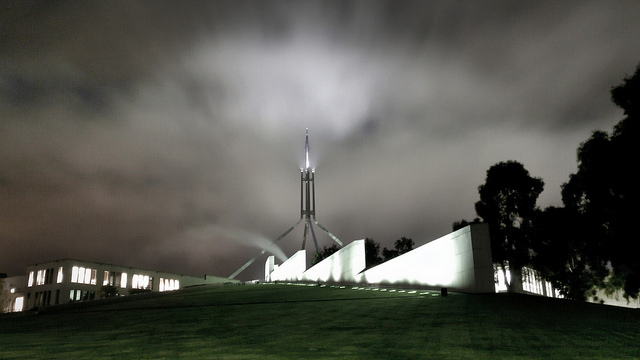DWP: Defence With Partisanship
Posted By Andrew Carr on January 24, 2017 @ 06:00

In his usual fashion, Peter Edwards’ recent report ‘Defence White Papers at 40 [1]’ offers an elegant, illuminating and historically grounded review. Edwards is right to cast his attention to this habit of government, noting that Australia managed to survive for 75 years without one, before producing seven in the next 40 years.
Given the growing dissatisfaction many have with recent documents, as well as the uncertainty of our times, his call to ‘draw breath’ on the practice is worth considering. As Edwards notes, his paper is far from alone in critiquing the quality of Australia’s contemporary strategic policy debate.
A common conclusion among the critics is the need for institutional change. Edwards argues for better use of parliamentary statements and use of the committees. James Brown [2] has called for better involvement and education of our politicians on strategy; John Faulkner [3] for better judicial oversight of intelligence; and many voices [4] have supported parliament taking away from the executive power over the use of force.
That is, more positions of authority, more power to parliament, more independence for auditors and assessors. Where the culture of the debate is mentioned, it’s simply to refrain that we have too much pointless bickering and need steady and strong bipartisanship. But I’m not sure the case can be made that Defence White Papers suffer from partisanship (as Edwards alleges) or that bipartisanship produces stronger documents.
We’ve had three significant Defence White Papers. Two of them are singled out for praise by Edwards: the 1976 and 1987 documents. Both of these however were fundamentally the product of partisan debate. While the 1976 document reflects the influence of both the Coalition (1966–1972 and 1975–6) and Labor (1972–1975), their differences were bitterly argued over at the time. The document reflected a fragile—and temporary—moment of agreement as both parties were forced to shift their world view (most notably with the Coalition accepting the limits of the alliance; the ALP accepting its benefits).
The 1987 White Paper was also a partisan document. The Hawke government needed to keep faith with the mainstream and the US alliance while managing its left wing. (A story set out most recently in Kim Beazley’s chapter on sovereignty and the alliance [5]). The Coalition strongly criticised the 1987 White Paper at the time, arguing it was a form of isolationism and a poor response to growing Soviet threats in the Pacific.
Those critiques would in time lead to the final standout and yet partisan document, the 2000 White Paper. The Coalition wanted to make a clear break with the Defence of Australia construct with big changes to how Australia chose its capabilities, what it used them for and how it explained these to the public. The document was then used by the Howard government to fully reclaim primacy in the politics of security and international affairs, which the Coalition had ceded to the ALP in the 1980s and early 1990s.
All three of those documents had core elements that reflected the differences of their authoring parties and those differences were strongly argued for following their release. These are wise documents, but they linger because their ideas were justified and defended at length in public. It’s hard to say Australia has suffered because of the political motives or ambitions contained within these documents.
By contrast the 2009, 2013 and 2016 DWPs all seem to have disappeared within months of their release. That’s a shame, as all contain different and potentially important ideas—2009 on China, 2013 on regional cooperation, 2016 on industry and capability. Yet in the spirit of ‘bipartisanship’, few if any of those ideas have been properly explored or explained to the general public. As such, scholars and public servants have been left with many questions, leading to confusion and at-times ad hoc policymaking.
It’s easy to be pessimistic about democracies today. Yet the story of the twentieth century is one of the democratic countries repeatedly having better strategies than their opponents. Those strategies were formulated because of partisan differences, democratic debate and public involvement, not in spite of them. Before we overhaul our system of government, we should try and allow it to operate as it was designed to: with the title ‘Leader of the Opposition’ meaning something, particularly when it comes to national security.
Ultimately, I think Edwards’ call for a pause in the production of Defence White Papers is wise. But that’s partly because our parties today don’t have enough to say on those issues. When they do—when we allow them to debate and divide on the question of defence—then we can return to producing such documents. Not until we allow our political parties to be political will we have another Defence White Paper worth storing on the shelf.
Article printed from The Strategist: https://www.aspistrategist.org.au
URL to article: https://www.aspistrategist.org.au/dwp-defence-partisanship/
URLs in this post:
[1] Defence White Papers at 40: https://www.aspi.org.au/publications/defence-white-papers-at-40/DWPs.pdf
[2] James Brown: https://www.quarterlyessay.com.au/essay/2016/06/firing-line
[3] John Faulkner: http://apo.org.au/resource/surveillance-intelligence-and-accountability-australian-story
[4] many voices: https://www.aspistrategist.org.au/parliament-must-vote-on-any-intervention-against-islamic-state-forces/
[5] on sovereignty and the alliance: https://www.mup.com.au/items/198597
Click here to print.